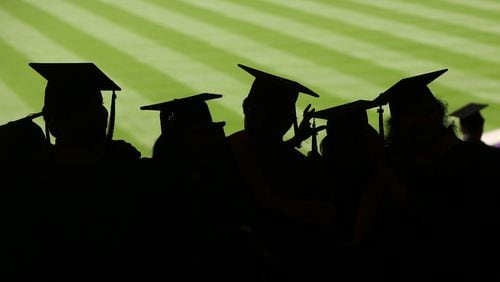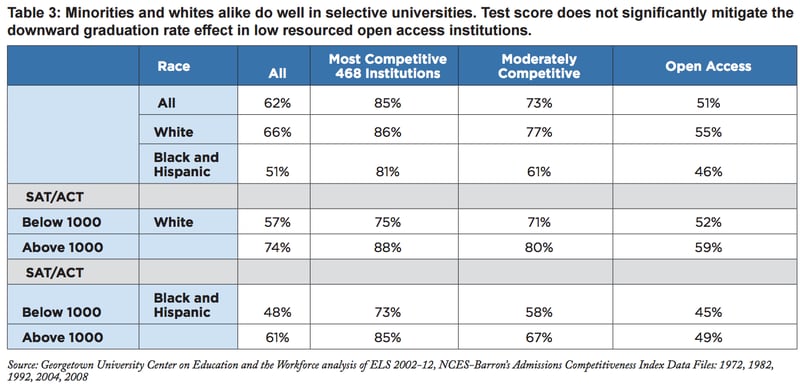An analysis from the Georgetown University Center on Education and the Workforce revisits a discussion we had here on the blog last week: Do students fare well at colleges that appear out of their academic league?
That question is under review because the U.S. Supreme Court is looking again at affirmative action and whether race ought to play any role in admissions at the University of Texas, Austin.
In 2008, white student Abigail Fisher sued after she was denied admission to the Texas flagship because she did not graduate in the top 10 percent of her high school class. Seventy-five percent of students admitted to the Austin campus reflect the “talented 10” policy that assures spots to students graduating in the upper ranks of their high school class. Fisher did not make the cut for the remaining 25 percent of admissions based on multiple considerations, including leadership, extracurriculars, honors, socioeconomic status, family composition and race.
During the Fisher vs. University of Texas hearing, Justice Antonin Scalia said, "One of the briefs pointed out that most of the black scientists in this country don't come from schools like the University of Texas. They come from lesser schools where they do not feel that they're being pushed ahead in classes that are too fast for them."
Metro Atlanta parents often complain their high-scoring teens were rejected or wait-listed at the University of Georgia or Georgia Tech because the two schools admitted less qualified rural or minority students. The problem, according to the disappointed parents, is that these "weaker" students won't succeed at such competitive campuses.
But the evidence suggests these kids do fine. And here is more evidence from Georgetown:
The theory that an average student, including minority students, will be overmatched at a selective university and will do poorly is empirically unsound, according to a new analysis from the Georgetown University Center on Education and the Workforce (Georgetown Center). In fact, all students with above average test scores will succeed at a higher rate at selective colleges than open-admission colleges.
As the U.S. Supreme Court prepares to decide this month on its latest affirmative action case (Fisher vs. University of Texas at Austin), justices have focused attention on the theory of “mismatch” that says college students will perform best at schools with students more like themselves. Supreme Court Justice Clarence Thomas expressed those thoughts in his dissent to the 2003 decision in Grutter v. Bollinger saying: “The Law School tantalizes unprepared students with the promise of a University of Michigan degree and all of the opportunities that it offers. These overmatched students take the bait, only to find that they cannot succeed in the cauldron of competition.”
“We’re holding qualified students back, particularly minorities, saying they can’t succeed when in reality, they indeed can,” said Anthony P. Carnevale, director of the Georgetown Center.
The Georgetown Center analyzed nationally representative data to demonstrate that the mismatch theory is wrong. The analysis shows that placing average students in the nation’s best colleges and universities will increase their rate of graduation by 26 percent.
“The data shows that three times more students are qualified to attend the top 468 universities than actually go to them,” said Jeff Strohl, director of research at the Georgetown Center.
The Facts
Lower scoring African-Americans and Hispanics — many from low-income backgrounds — do in fact fare much better when placed in academically challenging environments, even when other students are predominantly white (75 percent), and affluent (56 percent of students come from the nation's wealthiest families).
Students of varied races perform almost equally. White students in the bottom half of test scores have a graduation rate of 75 percent at the most selective colleges and universities, and those in the top half of test scores graduate at a rate of 88 percent.
For minority students, the graduation rate is 73 percent for those from the bottom half of test score and 85 percent for those in the top half of the test distribution.
Students at selective universities from the lowest test quartile have a higher graduation rate (68 percent) than do students from the top test quartile who attend open-access institutions (59 percent).
“The misconstrued belief that students with low test scores won’t succeed leaves behind half a million high school students every year who graduate in the upper half of their high school class but do not graduate from college,” said Jeff Strohl, director of research at the Georgetown Center. “And nearly half are minority students who would have been successful at selective institutions.”
Credit: Maureen Downey
Credit: Maureen Downey
Credit: Maureen Downey
Credit: Maureen Downey
Credit: Maureen Downey
Credit: Maureen Downey
The Fisher vs. University of Texas case stems from a law enacted in 1997 requiring the University of Texas to admit all high school seniors who ranked in the top ten percent of their classes and a later modification that allowed for considering race as a factor in admission for all other applicants. Abigail Fisher, a white female who was not in the top ten percent of her class, applied for undergraduate admission in 2008 and was denied. A judge denied Fisher’s claim that affirmative action violated the equal protection clause of the Fourteenth Amendment, but an appellate court overturned that ruling. The appeal later reached the Supreme Court, which is expected to issue a ruling later this month.










